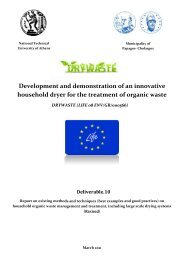MOROCOMP (LIFE TCY05/MA000141) - Unit of Environmental ...
MOROCOMP (LIFE TCY05/MA000141) - Unit of Environmental ...
MOROCOMP (LIFE TCY05/MA000141) - Unit of Environmental ...
Create successful ePaper yourself
Turn your PDF publications into a flip-book with our unique Google optimized e-Paper software.
2. Factors affecting the composting process<br />
The factors affecting the composting process include: the physical and chemical<br />
properties <strong>of</strong> the raw material, the level <strong>of</strong> oxygen, the moisture content, the<br />
temperature and the time over which the composting process takes place. These<br />
factors are outlined in the following sections.<br />
2.1. Oxygen and aeration<br />
The readily degradable components <strong>of</strong> the raw materials are metabolised during the<br />
initial period <strong>of</strong> composting. Therefore the production <strong>of</strong> heat and the need for oxygen<br />
are greatest at the early stages and then they steadily decrease. Without a constant<br />
supply <strong>of</strong> oxygen, the process will slow down. Approximately a 5% minimum<br />
concentration <strong>of</strong> oxygen is required within the pore spaces (given air contains about<br />
21% oxygen). If there is insufficient oxygen, the process can become anaerobic.<br />
Anaerobic decomposition involves a different set <strong>of</strong> micro-organisms and different<br />
biochemical reactions. Less heat is generated and the anaerobic processes are<br />
potentially less efficient than the aerobic ones. They can generate various substances<br />
and intermediate compounds such as methane, organic acids and hydrogen sulphide.<br />
Many <strong>of</strong> these compounds have strong odours and safety concerns. Although<br />
intermediate compounds, such as organic acids, are formed during aerobic<br />
decomposition, they continue to decompose when oxygen is available. Under<br />
anaerobic conditions, the intermediate compounds can accumulate. A constant supply<br />
<strong>of</strong> oxygen will give the aerobic microorganisms an advantage over the anaerobic<br />
micro-organisms. The existence <strong>of</strong> aerobic conditions is very important in avoiding<br />
the production <strong>of</strong> <strong>of</strong>fensive odours.<br />
Aeration is the process <strong>of</strong> providing oxygen into the composting material, as well as<br />
the mean to remove water vapour, gases and heat trapped within the materials.<br />
Temperature <strong>of</strong>ten is an indicator that determines how much and how <strong>of</strong>ten aeration is<br />
required, given that the required rate <strong>of</strong> aeration for heat removal can be much greater<br />
than that for supplying oxygen. Similarly the aeration rate required to reduce the<br />
moisture content is normally greater than that required for supplying oxygen, but less<br />
than the heat removal rate.<br />
12










